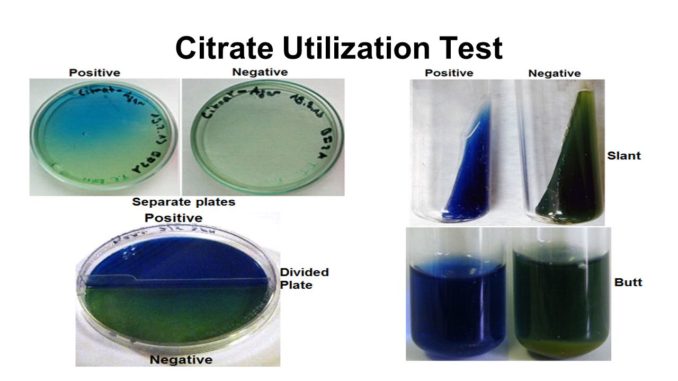
Citrate utilization test:
Objective
- to detect the ability of organisms to produce citrase enzyme.
Principle of citrate utilization test:
The basic principle of this test is to detect the ability of an organism which can utilize citrate as a sole source of carbon for their metabolism with resulting alkalinity. The citrase enzyme hydrolyses the citrate to form oxaloacetic acid and acetic acid.
Reaction:
Step I:
Citrate ——–citrase enzyme—-> Oxaloacetic acid + acetic acid
Step II:
Oxaloacetic acid———-> pyruvic acid + CO2
The test organism is cultured in a medium which contains sodium citrate and indicator bromothymol blue. Change in color of indicator from light green to blue due to alkaline reaction is indication of citrate utilization by the test orgaism.
All coliforms metabolize citrate when the molecule is generated inside the bacterial cell. But not all coliforms produce transport enzyme that bring citrate from environment across the cytoplasmic membrane and into the cell. In bacteria, that utilize citrate, the cleavage of citrate involves an enzyme system without the intervention of coenzyme. This enzyme system requires a divalent cation for its activity which is supplied by the Mg++ or Mn++ ion. The product obtained from the citrate metabolism depends on the pH of the medium. In alkaline medium, mostly acetic and formic acid are produced.
Pyruvic acid————–> Formoc acid + Acetic acid + CO2
In acidic medium, acetoin and lactic acid are produced
Pyruvic acid————–> acetoin + Lactic acid + CO2
In both cases, there is production of CO2 which then combines with sodium present in medium to form Sodium carbonate, an alkaline product.
Na + CO2 ———–>Na2CO3
The organisms capable of utilizing citrate as sole source of carbon can also utilize ammonium salts as sole source of Nitrogen. When ammonium salts are used by microorganisms, it breakdown into NH3 which increases the pH of medium.
The Citrate medium contains ammonium salts as sole source of Nitrogen and Citrate as sole source of carbon. It also contains a pH indicator bromothymol blue, which is green as neutral pH and changes to deep prussian blue at alkaline pH above 7.5. Henc, the formation of green color ie. no change in color indicates negative citrate test while the formation of blue color indicates positive citrate test.
Requirements
- Simmon’s citrate agar slant
- Given bacterial samples ( E. coli and Klebseilla)
- Inoculating loop
Procedure of Citrate utilization test
- Prepare Simmon citrate agar or Koser’s citrate medium in test tubes, taking 5 ml medium by autoclaving at 15lbs for 15 minutes.
- tilt the test tube containing melted citrate medium to prepare distinct slant and butt.
- Inoculate the given sample of organism were on the slant of the media using sterile wire and label the tubes
- Incubate the tubes at 37°C for 24 -48 hours.
- Observe the color change in the medium
Result:

- Citrate test Positive: color of media change to blue ( Klebsiella spp)
- Citrate test Negative: No change in color of media ( E. coli)
